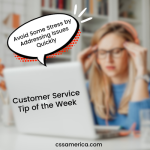In the wonderful world of texting and 140 character Tweets, where the ultra-brief is ultra-in, e-mail in business needs to be viewed as a different animal. It’s different than LOL and OMG. It’s different than #CoolBeans. It’s a business letter. It reflects on your professionalism, intelligence, level of empathy, and communication skills.
Sometimes people get lazy with e-mail; they press “Send” when they really should have called instead. Or they press “Send” without reviewing it, and then miscommunications and hurt feelings result.
So let’s review a quick list of e-mail tips; first the “Do’s.” Do. . .
- Use the “1 Minute Test;” ask yourself, could someone read this e-mail, and in one minute understand the key points and what they must do? If not, modify it to remove any barriers to the e-mail being read.
- Use personalized greetings/closings to set a professional/cordial tone.
- Use it when you need to set clear expectations of what will happen next, and by when.
- Include your contact information (particularly phone and, if possible, address) in the footer to make it easy for the reader to know how to contact you via other means.
- Use ALL CAPS only in Header Sections. This can help on longer e-mails or to ensure the reader’s understanding.
Now the “Don’ts.” Do NOT. . .
- Send without proofing and spell-checking – E-mails riddled with spelling errors can make you and your message lose credibility.
- Seem defensive, sarcastic, or purely negative – It brings in negative emotion, which is especially risky in written form.
- Overuse e-mail “shorthand” – It can be misinterpreted by the reader or simply not understood; one client got an e-mail from his boss saying “LOL.” The boss meant “Laugh Out Loud.” The employee thought he meant “Lots of Love.”
- Write hastily without reviewing for content, tone, ease of reading, etc. – It makes you appear impatient in your e-mail response.
- Use e-mail as a weapon such as copying the recipient’s supervisor when you have a complaint (particularly if this is the first time you’ve addressed the issue) – It’s unprofessional and weak, and it can break down trust/relationships.
- Use e-mail when something is urgent – Many people today still do not check e-mail that frequently; phone and face-to-face are better avenues.
- Use e-mail if at all possible when responding to complaints, particularly where emotions are involved – Negative emotions and e-mail rarely mix well.
- • Use e-mail when a series of questions are being asked (or comments being shared) back and forth – It’s turned into a conversation at this point; pick up a phone or go visit the person to dialogue instead.
When it comes to professionalism in business writing, don’t (E)-mail it in.











